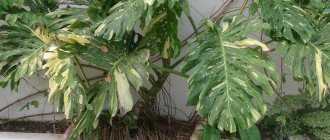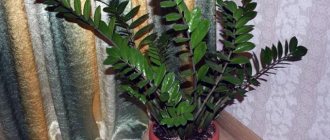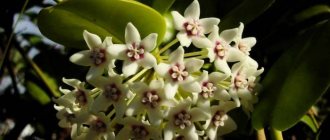The plant nephrolepsis (Nephrolepis) is a species of the genus of ferns of the Lomariopsis family. In some classifications, this plant is classified as a member of the Davalliaceae family. The Latin name was formed from two Greek words “nephros” and “lepis”, which translate as “buds” and “scales”, this is due to the shape of the veil. About 30 species of this plant are found in the wild, and it is distributed throughout the world. Nephrolepsis comes from the shady forests of tropical America, Southeast Asia, Africa and Australia. Fern is grown as a hanging or potted plant and used as decor for various interiors. In addition to the fact that such a plant has a spectacular appearance, it also perfectly purifies the air.
Meet Nephrolepis
Nephrolepis is a herbaceous plant that is an epiphyte or grows on the ground. It has an underdeveloped stem that produces short shoots.
Lush greenery of fern will decorate any interior
The homeland of this lush splendor is regions with a tropical climate. In the wild it can be found in Africa, Asia, America, Australia, even Japan and New Zealand. Under natural conditions, the fern grows very quickly.
Its long feathery leaves, called fronds, are collected in a rosette. The fronds can reach 70–80 cm in length.
Contrary to the legends about fern flowers, the plant is non-flowering and reproduces by spores, dividing the bush or layering. The spores are collected in groups, forming so-called sporangia. They look like miniature, initially green, convex dots, and as they mature, they become brownish fluffy lumps. They are located on the underside of the leaves.
Many spores mature in fern sporangia. which will subsequently give rise to new colonies of the plant
Several types of nephrolepis are bred at home. Among them there are unpretentious ones that do not cause much trouble, and there are also capricious picky ones with whom you will have to tinker. Which option is preferable is up to each owner to choose for himself, but in any case, the efforts will be rewarded. A healthy plant unusually enlivens the interior with a cap of lush leaves.
The green mass of fern not only produces oxygen, but also has antimicrobial activity. Nephrolepis absorbs formaldehyde, xylene, and toluene from the air generously released by household items.
Indoor types of nephrolepis
There are several varieties of nephrolepis that gardeners grow as indoor plants:
- Nephrolepis sublime;
- nephrolepis Boston;
- nephrolepis cordifolia;
- nephrolepis xiphoid;
- nephrolepis Green Lady;
- Emin's nephrolepis;
- blechnum, which belongs to the Derbyankov family.
Nephrolepis exaltata
One of the most commonly found ferns in home cultivation. The plant is unpretentious, caring for it will not be difficult. Its long (up to 50–70 cm) green fronds are collected in a lush rosette. Aged leaves turn yellow and dry out before falling off.
Nephrolepis sublime is one of the most common varieties of fern.
This variety can reproduce both by dividing the bush and by spores. Nephrolepis sublime gave rise to the breeding of a mass of hybrids.
Nephrolepis exaltata var Bostoniensis
A variety bred, as the name suggests, in Boston from Nephrolepis sublime. It is distinguished from its progenitor by wavy, twisted leaves. The fronds of this species can reach 1.2 m in length. He gave rise to the breeding of varieties with leaves of complex shape, consisting of two, three and four leaves fused together. This variety is most resistant to dry air.
Boston nephrolepis is distinguished by its original wavy leaves
Nephrolepis cordifolia
This representative of the family owes its name to the original shape of the leaves on long, almost vertically growing fronds.
When you see the leaves of this variety, the origin of its name becomes clear.
Tuberous formations can be seen on the root system of this species. Sori are attached along the underside of the heart-shaped leaves. This species, like the previous one, reproduces by spores and division of the bush.
Nephrolepis bisserata
The leaves on the fronds of this species have the shape of pointed swords. Spores are attached to the green leaves on the underside. This plant does not form tubers. A distinctive feature of Nephrolepis xiphoidum is its lush crown, reaching 1.5-2 m. Fronds of this size make this variety inconvenient for cultivation at home in an ordinary apartment. You can meet this giant in greenhouses and winter gardens.
The pointed sword-shaped shape of the leaves clearly distinguishes this variety from other ferns.
Nephrolepis Green Lady
A variety of fern characterized by a spherical “fountain” of green, pointed leaves. The fronds are densely covered with lacy lobes growing close to each other. The plant is demanding on air humidity.
Strong, lush fronds of Green Lady are big fans of humidified air
Nephrolepis Emina
A low-growing compact plant whose fronds are elastic and almost vertical. Its second name is Dragon Tail (dragon tail) or Green Dragon (green dragon). Its unusual “curly” leaves make it especially attractive. This species grows up to 50 cm
Nephrolepis Emin strikes with elastic fronds covered with curly leaves
Blechnum is another representative of ferns popular among gardeners, although from a different family - the Derbyankovyh. In natural conditions, its fronds reach a length of up to 1.5 m. It has earned recognition among indoor plant lovers thanks to its fronds covered with green palm-shaped leaves. With age, the rhizome grows above the ground and changes, becoming like a trunk. The plant as a whole resembles a palm tree. This type of fern is capricious and demanding in terms of growing and care conditions, but for the sake of such beauty it is worth trying. At home, with proper care, fronds can reach a length of up to 1 m.
The lignified modified rhizome and fronds with long leaves give the blechnum a resemblance to a palm tree
Botanical description
Nephrolepis flower is a herbaceous plant, epiphytic or terrestrial, with a short rhizome, a rosette of light green, short-petioled pinnately compound leaves up to 70 cm long, consisting of lanceolate, serrate-crenate along the edge of segments up to 5 cm long, on the lower side of which on both sides the midrib contains round sori. With age, the leaves turn yellow and fall off. Leafless shoots, covered with scales and easily rooting, extend from the rhizome.
Conditions for keeping nephrolepis at home
Keeping nephrolepis at home requires compliance with certain parameters, as well as rules of care depending on the time of year.
Table: requirements for keeping nephrolepis at home
| Season | Lighting | Humidity | Watering | Temperature | Top dressing |
| Summer | Diffuse, bright light, preferably located on windows facing west or east. Direct sunlight is contraindicated. Possible placement on a balcony, loggia, terrace in partial shade | Humidity - at least 60%. Requires daily spraying with warm soft water. It will help to place a pot of flowers on a tray filled with moss and expanded clay soaked in water. The container with the flower should not be immersed in water | Watering is sufficient, you need to focus on drying the top layer of the substrate | +20о…+24оС | Fertilizers produced for ornamental plants are used weekly in diluted form (1/4 or 1/2 of the recommended amount) |
| Winter | In winter, additional artificial lighting may be required for at least 6–7 hours | Humidity - at least 60%. Requires daily spraying with warm soft water. It will help to place a pot of flowers on a tray filled with moss and expanded clay soaked in water. The container with the flower should not be immersed in water | Water carefully, 2-3 days after the top layer dries. | +16о…+18оС | Extremely rare, it is better to completely stop feeding - excessive efforts at this time are fraught with disastrous consequences for the plant |
Fern Nephrolepis in the expositions of the florarium
A florarium is an original composition of flowers with the addition of various decorative elements, placed in a transparent vessel made of glass or plastic.
A number of varieties of nephrolepis, due to their compact size, are used in the preparation of compositions for florariums. The variety Bostoniensis Compacta, bred from Boston nephrolepis, has a very small size (up to 40 cm). This feature allows it to be used for growing in florariums. This species is quite unpretentious; in a florarium, subject to high levels of humidity and temperature conditions, it will delight the owner with juicy greens. To compose florarium compositions, you can also pay attention to varieties such as Dallas Jewel, Teddy Junior. They are small in size, organically fitting into florarium ensembles.
Croton is also perfect for a florarium, read about it:
Photo gallery: florariums using ferns
Small size allows the plant to be used in florariums
Florarium is a composition of flowers and various decorative elements
Small ferns fit original into frolarium ensembles
Indoor flowers
Species with leaf heights of no more than a meter are grown indoors. Thanks to breeders, a large number of varieties have appeared that differ in the size and shape of the leaves.
The most common of them:
- Exalted;
- Emina;
- Boston;
- Cordifolia;
- Green lady.
Read more about the varieties of nephrolepis fern here.
Nuances of care
It is not difficult to care for this green miracle. It must be remembered that the plant is a native of the tropics. Hence the increased sensitivity to dry air and watering.
Lighting
Nephrolepis is a lover of light; it should be placed in places with sufficient illumination, trying to avoid the sun's rays hitting the plant directly. Windows facing east or west are suitable. Nephrolepis does well under artificial light: it can often be found in various offices and institutions, where the fern gets enough light from lamps running for a long time.
In summer, the green pet can be taken out into the open air, not forgetting to provide shade from the sun to avoid burns.
In winter there is little light in the rooms, so additional lighting will be useful.
Humidity
A native of the humid tropics, Nephrolepis requires humidified air. Daily spraying with soft (necessarily warm) water will help, and in the summer it must be done in double volume.
You can place the plant on a moistened tray filled to the top with some kind of filler (expanded clay, moss). It’s just important not to “drown” the bottom of the pot: it should stand as if on a stand. These requirements must be observed regardless of the season.
Nephrolepis will respond gratefully to shower procedures. Warm water will not only keep the leaves moisturized, but will also wash away accumulated dust.
Humidified air is suitable for growing mimosa pudica. Read more about this exotic plant:
Top dressing
Nephrolepis needs to be fed depending on the season. In summer - 1 time every 7 days. For feeding, you can use fertilizers recommended for ornamental plants, diluted by half or 3/4 with water.
In winter, fertilizers are used to a minimum, and it is better not to feed at all, since applying an excessive amount of fertilizer during this period can lead to plant disease.
Some mistakes in caring for it can have an adverse effect on the health of the plant.
Table: errors in organizing care for nephrolepis
| Symptoms | Possible errors | |||
| Watering | Temperature | Humidity | Top dressing | |
| Leaves turn yellow and dry | Excess water - the lower leaves turn yellow, their tips turn brown and dry out. Lack of water - the growth of leaves stops, their lethargy and yellowing are observed. Cold water. Hard water | The leaves turn yellow from the base - unfavorable temperature, should be moved to a cool place. When the temperature rises (>25°C), increase the frequency of spraying. When the temperature drops (<12°C) - reduce the volume and number of waterings | Spraying in direct sunlight | — |
| Young fronds wither and die | Use for cold water irrigation | Reduced temperature | Low humidity, the number of sprays should be increased | — |
| The plant fades and stops growing | — | — | — | Not enough nutrients, add fertilizer |
| Leaves turn yellow over time | Natural process, dried fronds should be removed | |||
Table: diseases and pests of nephrolepis
| Diseases and pests | Symptoms | Ways to fight | Prevention measures |
| Gray rot | Gray fluffy coating on leaves, cuttings | Treat with fungicide (Trichophyte, Alirin-B) | Avoid stagnation of water, water with cold water at low temperatures |
| Spider mite | White dots appear on the leaves, the leaves gradually dry out, with severe damage a thin web is visible | Wash with warm water and laundry soap, in case of severe damage, treat with special products (Aktellik, Aktara, Condifor) | Regularly ventilate the room, spray the plant, periodically wash it in the shower |
| Whitefly | Yellowish spots appear on damaged leaves. the leaves dry out | Wipe the leaves with a water-alcohol solution (1:1). Treat with insecticides (Fitoverm, Aktellik, Aktara, Condifor) | Observe the temperature and water conditions, avoid high temperatures and high humidity - ventilate the room more often, regularly wash the flower in the shower |
| Mealybug | A white coating appears on the leaves, they look damaged and turn yellow. Pests are visually visible | Wash the fern with soapy water, and after drying, treat with insecticides (Fitoverm, Aktellik, Aktara, Inta-Vir) | Regularly inspect the plant, ventilate the room, spray, wash |
Reproduction of nephrolepis
Nephrolepis can be propagated in several ways:
- disputes;
- dividing the bush;
- shoots;
- tubers.
Reproduction by spores
This method is difficult due to the likely sterility of spores from domestic crops or the presence of incomplete hereditary information about the parent. If you really want to, you need to do the following:
- Carefully separate the ripened grains with a knife, placing them on paper.
- Place the spores on the prepared soil. Drainage is required. For the greenhouse you need to use a plastic container with a lid.
- Place the seeds on a moistened substrate, cover with a lid and leave in a warm, shaded place.
- The incubator should be ventilated and the soil moistened periodically. Under favorable circumstances, it will take about three months for the seeds to germinate. When the sprouts grow and become stronger, they need not be covered.
- The shoots that have formed a rosette can be planted.
Spores of domestic nephrolepis cultures can be sterile, so this method of propagation is difficult and rarely used
Reproduction by dividing the bush
This is the simplest and most common option:
- During spring transplantation, the rhizome is divided into several parts. It is necessary that each new bush has a growth point.
- Small bushes are planted separately.
Reproduction of nephrolepis by dividing the bush during transplantation is the simplest and most common option.
Reproduction by shoots
The “whiskers” hanging seemingly idle will help you get a new fern:
- Leafless shoots should be taken to the side, pressed to the substrate and placed in a separate container.
- They need to be buried so that the middle is covered with soil by about 1 cm.
- We must not forget about constant hydration.
- After two weeks, roots will appear, and then small shoots. When the young shoots become stronger, they can be separated from the mother plant and planted separately.
For this method of propagation, leafless shoots of nephrolepis are taken to the side and pressed to the ground in a separate container until they take root.
Propagation by tubers
Some species form moisture-saving tubers on their roots. They can be clearly seen when transshipping the plant. This propagation method is incredibly simple:
- The tuber is separated from the roots.
- Then it must be placed in the prepared substrate.
- The soil is moistened as usual.
Tubers form on the roots of many types of nephrolepis, which are excellent for plant propagation
What it looks like in the interior of a bathroom
Nephrolepis can completely transform your bathroom. It will look great as a single plant or in a composition. Unlike most indoor flowers, it thrives in shade and high humidity. The microclimate of the bathroom perfectly imitates its natural living conditions. However, if there is no window in the bathroom, it needs lighting for 16 hours.
Photo
The photo shows several options for what nephrolepis looks like in the bathroom:
Reviews about the plant
This is one of the most unpretentious ferns, a very spectacular plant.
I dearly love this unpretentious indoor fern. In September, I planted a huge basin-like pot, and everyone was gifted with ferns. But it didn’t start growing well for me right away. First, I managed to get a plant with three half leaves, around which I danced with a tambourine, I really wanted a big beautiful fern. But my dancing didn’t bother him one bit, and he kept standing there, apparently wondering whether life was worth living. And so, while digging through the Internet in search of an answer to what he needs, I came across a recipe that I want to share. To replant, you need to dilute the soil very generously with pine bark. We also add pieces of coal, pine litter, and you can add sphagnum moss. It wouldn’t hurt to mix in some sand if the land is purchased, otherwise there is usually only peat. And it’s better to take a flat pot, not a tall one. Transplanted in this way, my little one somehow quickly recovered and began to grow, and now there are no problems with it. But it does not like drying out, and it is better to monitor the soil moisture. After all, it stands high, and the fact that it is dry is not immediately noticeable. The fronds do not wither, but just somehow turn pale and begin to dry out at the tips of the leaves. But the saddest thing is that the “snails” dry up without having time to turn around. A beautiful house plant, unpretentious and grateful for care, I recommend it! irkin44 https://irecommend.ru/content/zelenyi-vodopadik-sekret-uspeshnoi-posadki
I have the same.
It needs to be moved to the window, otherwise the leaves are long and sparse. But when it fluffs up - oh, and handsome! All the guests are looking in. Elf https://otzovik.com/review_217759.html
I've had ferns for a long time, about 15 years to be exact.
I'm always surprised when you complain about the lack of light for them. In my experience, they are only beautiful and green in winter. When spring comes and the sun comes, they begin to turn pale. If I take them out into the yard and onto the completely shady side, where the sun never hits them, it’s the same thing. They become pale. Here are mine on the veranda in winter, now I have already taken them off and hid them in the northern rooms. Jike https://forum.bestflowers.ru/t/nefrolepis-nephrolepis.146911/page-51
I love this plant for its luxurious thick greenery, for the interesting observation of how a beautiful carved frond appears from the “snails”, and so on ad infinitum!
My little children kept coming up and waiting for little green, furry balls to appear on the surface of the earth, changing in size every day. The plant survives quite well. But if you want it to be a rich green color, it needs to be provided with favorable conditions. The main thing is not to overwater, often spray with settled water, do not feed with fertilizers, it is enough to fertilize twice with liquid fertilizer for ornamental flowering plants. In very bright light, nephrolepis fronds turn pale, so it should not be placed on a southern window. But it also fades in the shadows. The most successful window will be the eastern one. On New Year's Day we decorate it with rain, it looks very original. A very good fern with lush forms. Clarice https://irecommend.ru/content/ochen-khoroshii-paporotnik-s-pyshnymi-formami-foto
I love ferns; I have several of them at my summer cottage.
Maybe that’s why I love nephrolepis, because it is also a representative of ferns. Amazingly beautiful at home. It is not difficult to grow, it grows very quickly and is unpretentious. It prefers moist soil, likes spraying, grows well in partial shade, fertilizing is needed from time to time. Anna Zakharchuk https://flap.rf/Animals_and_plants/Nephrolepis/Reviews/6437440
Video: caring for nephrolepis at home
Nephrolepis is a very beautiful and unpretentious fern. With proper care, this tropical guest will delight the owner with lush, fresh foliage. This spreading plant adapts well to city apartments, being a bright interior decoration.
- Author: Olga Kuznetsova
Being a diligent student at school, I listened carefully to the advice of teachers. They could not decide where I could better reveal my abilities - physics and humanities or the humanities. Rate this article:
- 5
- 4
- 3
- 2
- 1
(2 votes, average: 5 out of 5)
Share with your friends!
Transfer
Once a year in March or April, it is necessary to transplant the fern into a larger pot, since nephrolepis grows at a very high speed.
For replanting, be sure to use light, slightly acidic soil for ferns. The fern pot should be wide and low. It is very important not to bury the nephrolepis rosette - this leads to its rotting.











